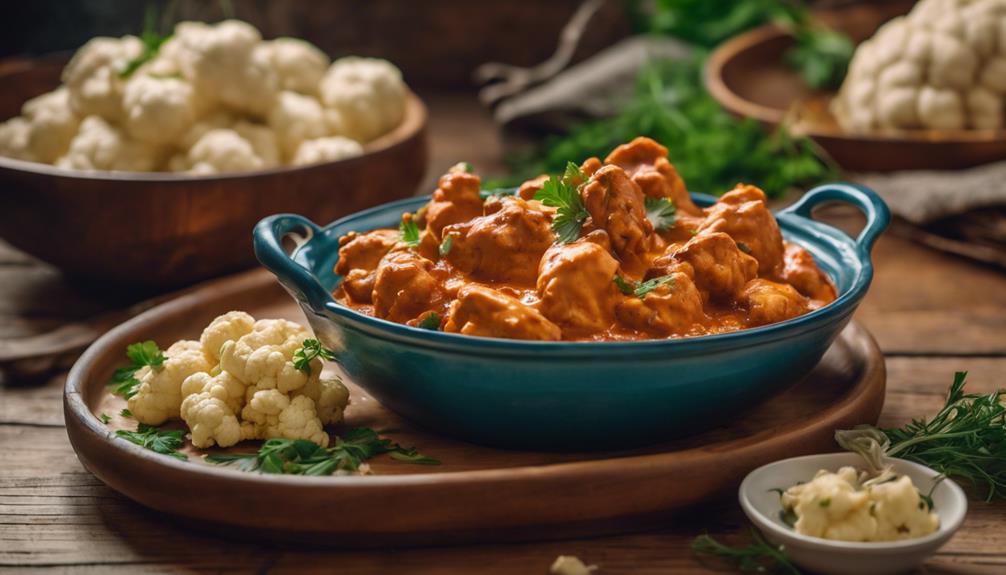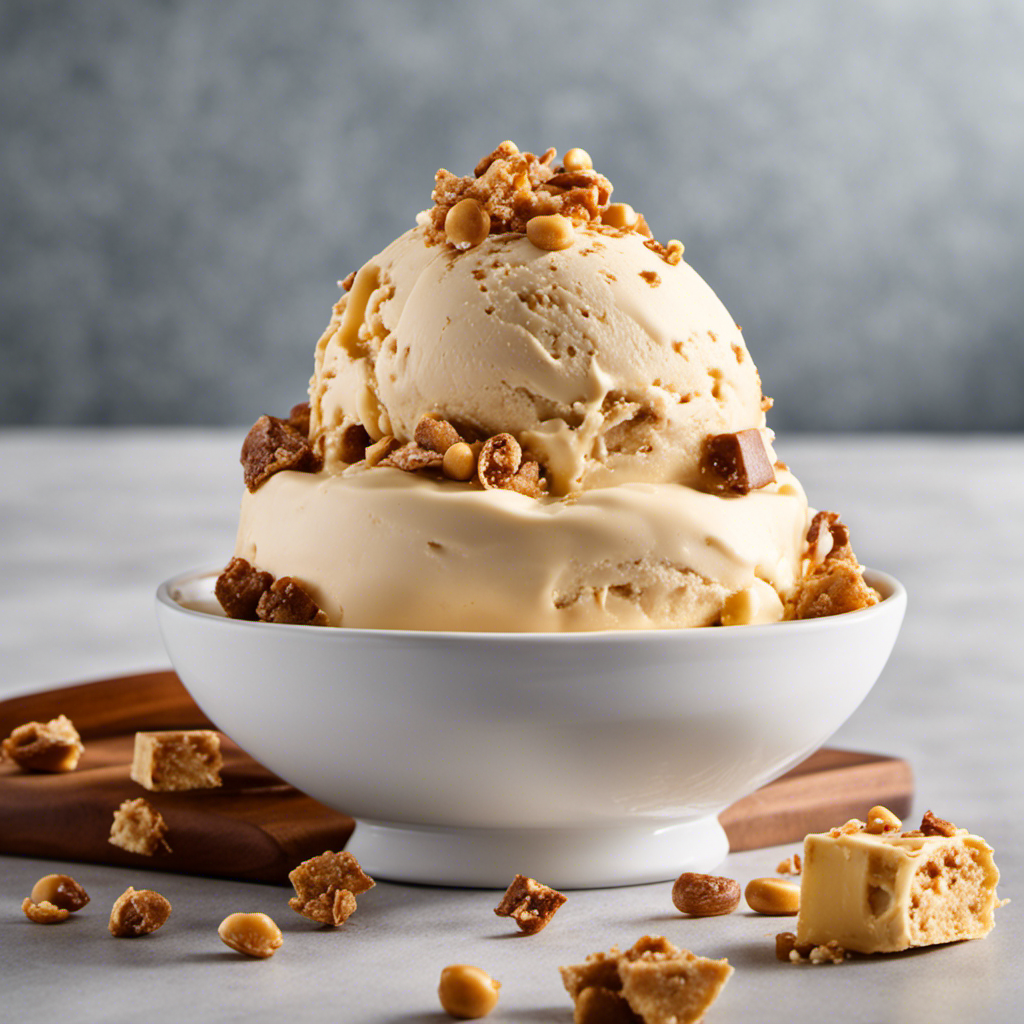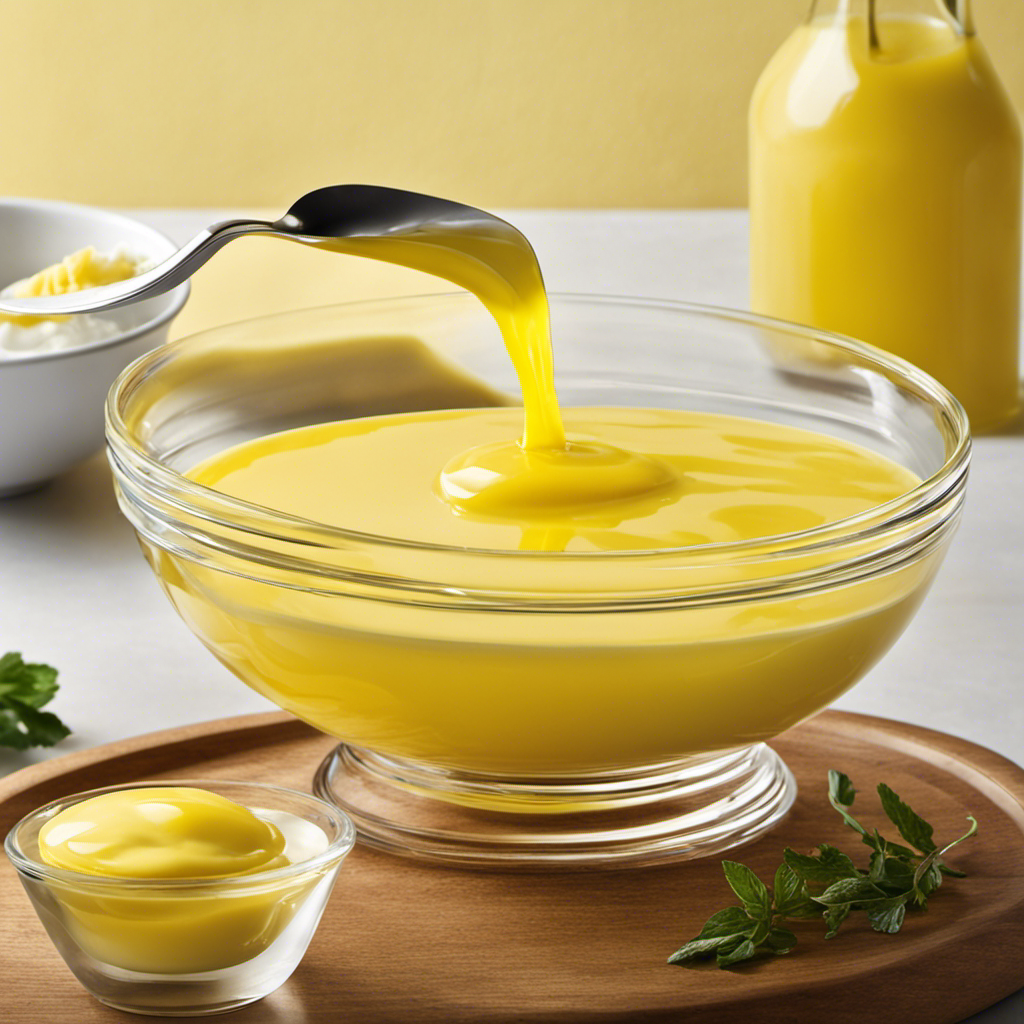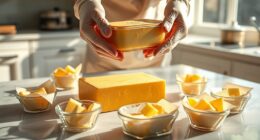Pairing butter chicken with a complementary vegetable dish enhances the meal's richness and diversity. Saag Paneer, with its creamy spinach and paneer, matches butter chicken's texture and visual appeal. Aloo Gobi offers a flavorful mix of tender cauliflower and potatoes, adding satisfying contrast. Baingan Bharta's smoky, roasted eggplant complements the chicken's creamy sauce. Try Bombay Potatoes for a crispy, aromatic touch or Chana Masala for a hearty, tangy boost. Palak Paneer's vibrant and nutrient-rich spinach dish also works wonders. Continue for more delicious pairings to elevate your feast.
Key Takeaways
- Saag Paneer's creamy spinach and paneer cheese complement butter chicken's rich texture and appearance.
- Aloo Gobi's tender cauliflower and potatoes provide a flavorful, spicy contrast to butter chicken.
- Baingan Bharta's smoky roasted eggplant offers an earthy, creamy pairing with butter chicken's sauce.
- Chana Masala's hearty chickpeas add a tangy, protein-rich side that balances butter chicken's flavors.
- Vegetable Biryani's aromatic, spice-infused rice and mixed vegetables enhance the overall dining experience with butter chicken.
Saag Paneer
When pairing vegetables with butter chicken, Saag Paneer's creamy spinach and paneer cheese offer a nutritious and flavorful contrast. As a classic North Indian dish, Saag Paneer combines the vibrant green of spinach with soft, melt-in-your-mouth paneer cheese. This vegetarian delight isn't just rich in flavor but also packed with essential nutrients like iron, calcium, and protein.
The creamy texture of the spinach melds beautifully with the bold, savory flavors of butter chicken, providing a harmonious balance on your plate. While butter chicken's rich, tomato-based sauce brings warmth and depth, Saag Paneer's slightly tangy and creamy spinach offers a revitalizing counterpoint. The paneer cheese, with its mild taste and satisfying bite, complements the tender chicken, making each mouthful a delightful experience.
Serving Saag Paneer alongside butter chicken also brings a visually appealing contrast, with the vibrant green of the spinach adding a pop of color to the meal. It's not just about looks, though; the combination of textures and flavors will elevate your dining experience, making Saag Paneer an excellent choice when you're looking to enhance your Indian-inspired feast.
Aloo Gobi
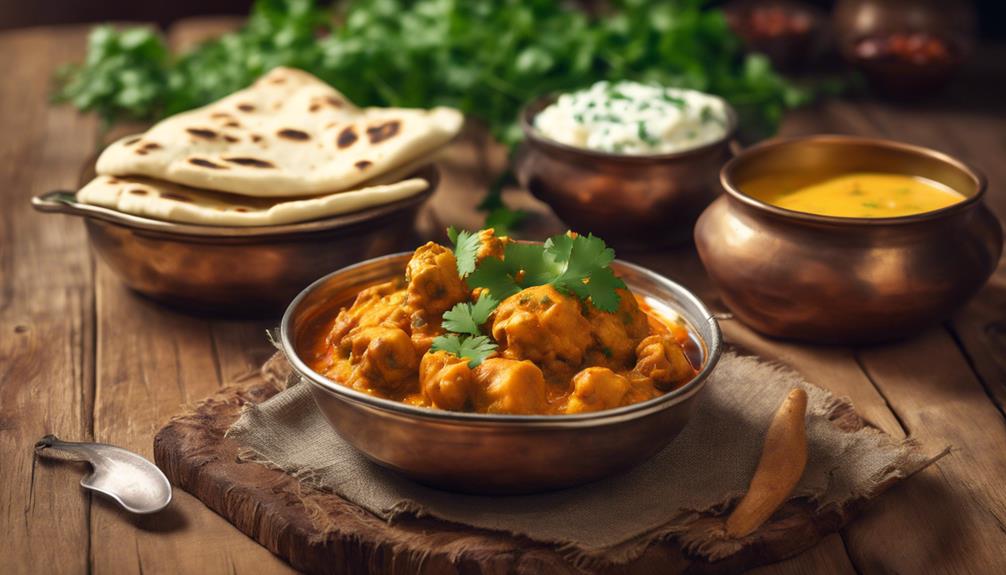
You'll love how Aloo Gobi's flavorful spice combination enhances the taste of Butter Chicken.
Its tender cauliflower and soft potatoes provide a satisfying textural contrast.
Plus, the similar cooking methods make preparation a breeze, ensuring both dishes complement each other perfectly.
Flavorful Spice Combination
Aloo Gobi's mix of spices, such as turmeric, cumin, and coriander, enhances the robust flavors of Butter Chicken while providing a delightful contrast in texture. This traditional Indian dish, prepared with tender cauliflower and soft potatoes, offers a flavorful spice blend that complements the creamy and savory profile of Butter Chicken perfectly. As a popular vegetarian side dish, Aloo Gobi brings a nutritious and satisfying element to your meal.
The fragrant spices in Aloo Gobi not only elevate the dish itself but also blend beautifully with the bold taste of Butter Chicken. Turmeric imparts a cozy, earthy flavor while cumin introduces a touch of smokiness, and coriander adds a zesty, citrusy touch. Together, these spices create a symphony of flavors that enhance each bite.
When preparing Aloo Gobi, you'll observe how the cauliflower and potatoes soak up these spices, making them the ideal base for the rich Butter Chicken sauce. This flavorful spice blend guarantees that every mouthful is a delightful experience.
Textural Contrast Benefits
Pairing Butter Chicken with Aloo Gobi introduces a satisfying textural contrast that enhances the overall dining experience. The creamy sauce of the butter chicken perfectly complements the soft, tender bites of cauliflower and potatoes in Aloo Gobi. This combination not only adds a hearty element to your meal but also balances the rich flavors of the butter chicken.
By including Aloo Gobi, you bring a diverse mix of textures that keep each bite interesting. The cauliflower and potatoes provide a substantial, hearty base that contrasts beautifully with the smooth, velvety texture of the butter chicken sauce. This contrast makes every forkful a delightful blend of creamy and tender elements, enhancing your enjoyment of the meal.
Moreover, Aloo Gobi is a versatile dish that seamlessly fits into any Indian meal, making it an excellent choice for pairing with butter chicken. Its ability to complement the dish while adding its own unique texture and flavor profile guarantees that your dining experience is both balanced and satisfying.
Complementary Cooking Methods
Exploring complementary cooking methods can further enhance the delightful pairing of butter chicken and Aloo Gobi. When preparing Aloo Gobi, start by sautéing the potatoes and cauliflower to create a base that absorbs the rich flavors of the accompanying spices. This step guarantees that both vegetables soak up the aromatic blend, making them a perfect match for the creamy, mildly spicy butter chicken.
Begin by chopping your potatoes and cauliflower into bite-sized pieces. Sauté them in a hot pan with a mix of spices like cumin, turmeric, and coriander. This initial cooking method not only infuses the vegetables with robust flavors but also softens the potatoes while keeping the cauliflower slightly crunchy. The contrast in textures—soft potatoes and crunchy cauliflower—adds an intriguing element to the meal.
Adding Aloo Gobi to your butter chicken provides a balance of flavors and textures. The spices in the Aloo Gobi complement those in the butter chicken, creating a harmonious blend. The mix of creamy chicken and spiced vegetables offers a satisfying, well-rounded meal. This combination guarantees every bite is a delightful experience, marrying the best of both dishes seamlessly.
Baingan Bharta
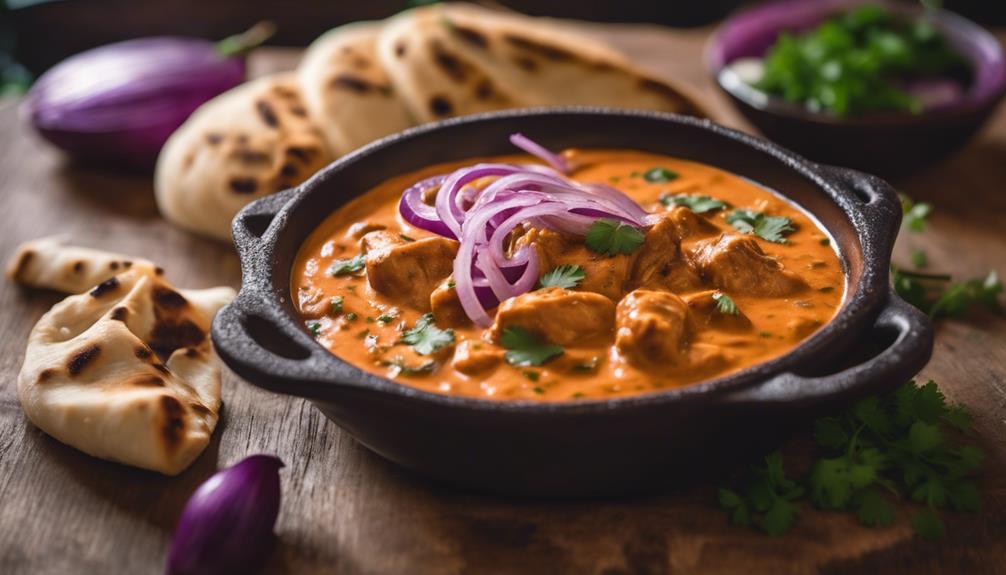
You'll find that Baingan Bharta's smoky, zesty flavors perfectly enhance the creamy richness of Butter Chicken.
Made with roasted mashed eggplant and seasoned with aromatic spices like cumin, coriander, and garam masala, this dish adds depth and texture.
Its creamy texture pairs seamlessly with the sauce, creating a satisfying combination.
Preparation and Ingredients
How do you prepare Baingan Bharta to complement your butter chicken perfectly? Start by selecting a medium-sized eggplant, the key vegetable in this delightful pairing. Roast the eggplant over an open flame or in the oven until the skin is charred and the flesh becomes soft. This step adds the essential smoky flavor that makes Baingan Bharta a great companion for creamy butter chicken.
Once roasted, let the eggplant cool slightly before peeling off the charred skin. Mash the softened flesh and set it aside.
In a pan, heat some oil and add cumin seeds until they start to splutter. Follow with finely chopped onions, garlic, and ginger. Sauté until the onions are golden brown.
Now, incorporate your aromatic spices: turmeric, coriander, and a pinch of garam masala. Add chopped tomatoes and cook until they break down into a thick sauce. Mix in the mashed eggplant and let it simmer, allowing the flavors to meld together.
The smoky, zesty Baingan Bharta, rich with spices, pairs wonderfully with butter chicken. This combination balances the creamy sauce of butter chicken with the robust flavors of the eggplant dish, making your meal truly extraordinary.
Flavor and Texture
When you combine Baingan Bharta with butter chicken, the smoky, earthy flavors of the eggplant dish perfectly complement the creamy richness of the chicken. This pairing creates a delightful culinary experience where the contrasting textures and flavors enhance each other. Butter chicken's smooth, velvety sauce blends wonderfully with the hearty, slightly charred texture of Baingan Bharta.
The table below outlines how these dishes contrast and complement each other:
| Aspect | Butter Chicken | Baingan Bharta |
|---|---|---|
| Texture | Creamy and velvety | Hearty and slightly charred |
| Flavor | Rich and mildly seasoned | Smoky and earthy |
| Main Ingredient | Chicken in a tomato-based sauce | Roasted, mashed eggplant |
| Complementarity | Provides a rich, creamy base | Adds depth with its robust, smoky notes |
The earthy and robust flavors of Baingan Bharta provide a delicious contrast to the mildly spiced butter chicken, making each bite more interesting. This combination guarantees a well-rounded meal with a variety of flavors and textures, offering a unique dining experience. Baingan Bharta's savory and smoky notes enhance the overall enjoyment, making it an ideal vegetable pairing for butter chicken.
Bombay Potatoes
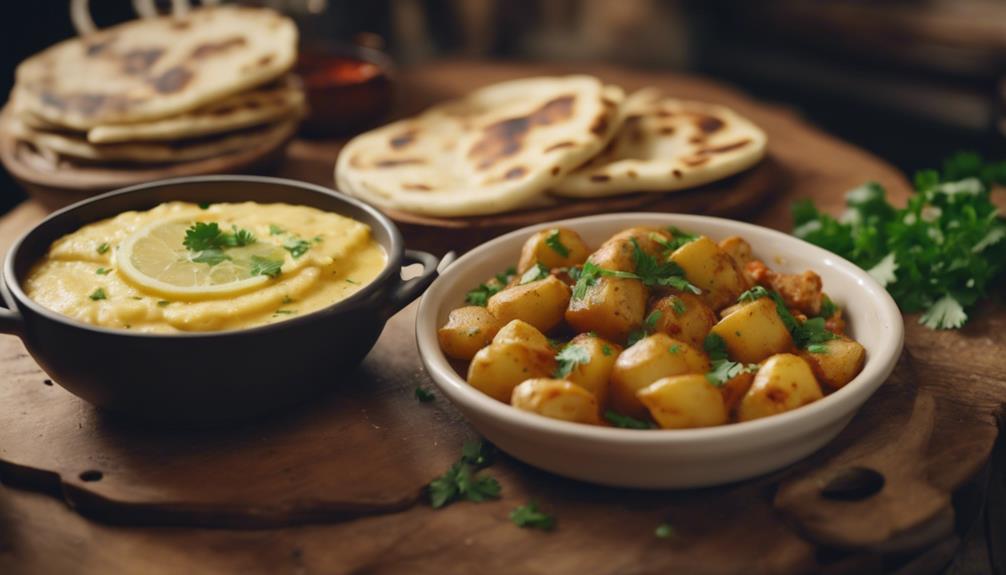
Bombay Potatoes, with their crispy exterior and tender interior, perfectly complement the creamy richness of butter chicken. This popular Indian side dish features baby potatoes cooked in aromatic spices that elevate any meal. When you sauté the potatoes with traditional Indian spices like cumin, turmeric, and garam masala, you create a flavorful and hearty element that enhances the dining experience.
The texture of Bombay Potatoes is a standout feature. The crispy outside contrasts beautifully with the soft interior, providing a satisfying bite that pairs well with the smooth, rich sauce of butter chicken. The aromatic spices used to prepare Bombay Potatoes add layers of flavor that meld seamlessly with the dish, making each mouthful an adventure in taste.
You'll find that Bombay Potatoes aren't only easy to make but also versatile. They pair wonderfully with naan or rice, giving you a variety of options for how to serve them. Whether you're hosting a dinner party or looking for a comforting meal at home, adding Bombay Potatoes to your butter chicken will make the meal feel complete and utterly delicious.
Palak Paneer
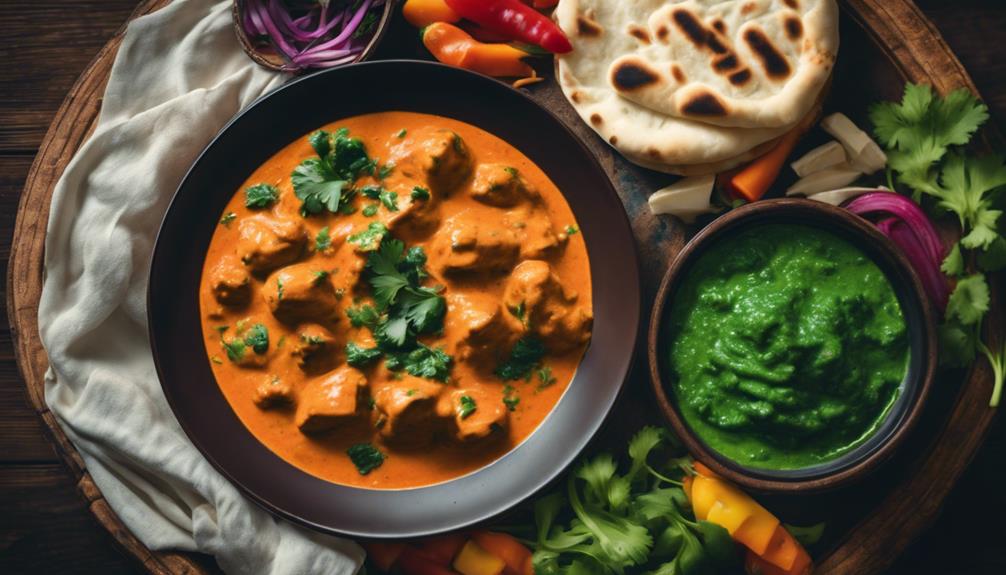
You'll love pairing butter chicken with Palak Paneer for a creamy spinach delight that complements the dish perfectly.
This nutrient-rich combination brings iron, calcium, and protein to your meal, boosting its health benefits.
The vibrant green and aromatic spices of Palak Paneer also add a revitalizing contrast to the rich, indulgent butter chicken.
Creamy Spinach Delight
Plunge into the velvety and flavorful world of Palak Paneer, a traditional North Indian dish that perfectly complements the rich and spicy Butter Chicken. This delightful side dish combines tender spinach with soft cubes of paneer, creating a harmonious blend of textures and tastes. The velvety consistency of Palak Paneer elevates your dining experience, offering a soothing contrast to the intense spices of Butter Chicken.
You'll find that the mild, slightly tangy flavor of the spinach melds beautifully with the smooth, rich paneer. This dynamic duo not only brings a burst of flavor to your meal but also enhances the visual appeal with its vibrant green and white palette.
When paired together, Palak Paneer and Butter Chicken create a balanced feast that tantalizes your taste buds and satisfies your cravings.
As you savor each bite, notice how the velvety texture of the Palak Paneer complements the tender, juicy chicken and velvety sauce of the Butter Chicken. This pairing guarantees a delightful combination of flavors and textures, making your meal an unforgettable culinary experience.
Nutrient-Rich Combination
Beyond its delightful taste, Palak Paneer offers a nutrient-packed punch that perfectly complements the indulgent Butter Chicken. The spinach in Palak Paneer is a powerhouse of nutrients, loaded with iron, vitamins A, C, and K. These vitamins boost your immune system and support overall health, making Palak Paneer a nutrient-rich choice.
Adding cottage cheese (paneer) to the mix not only enhances the dish's creamy and flavorful profile but also provides a substantial amount of protein and calcium. This makes Palak Paneer a balanced and wholesome counterpart to the rich and spicy Butter Chicken. The creamy texture of cottage cheese perfectly contrasts with the rich, buttery sauce, creating a delightful dining experience.
Here's a quick comparison of the nutritional highlights:
| Nutrient | Spinach (per cup) | Cottage Cheese (per cup) |
|---|---|---|
| Iron | 6.4 mg | 0.2 mg |
| Vitamin A | 2813 IU | 296 IU |
| Vitamin C | 8.4 mg | 0 mg |
| Protein | 0.9 g | 27 g |
Palak Paneer's vibrant green color and earthy flavors also add visual appeal, making your meal not just nutritious but also visually enticing. Pairing these two dishes guarantees a balanced meal that's both delicious and good for you.
Cauliflower Dry Fry

Cauliflower Dry Fry, with its crispy texture and aromatic spices, makes a perfect side dish for butter chicken. This flavorful Indian veggie dish is a delightful complement to the creamy richness of butter chicken. By using the dry fry method, you ensure the cauliflower retains a satisfying crispiness, creating a wonderful contrast to the tender, saucy chicken.
To make this dish, you'll start with fresh cauliflower florets, which are then seasoned with a blend of aromatic spices like cumin, coriander, and turmeric. These spices infuse the cauliflower with an intense flavor that perfectly balances the buttery, tomato-based sauce of the butter chicken. The result is a harmonious pairing that elevates your meal to a new level of deliciousness.
Moreover, Cauliflower Dry Fry is incredibly versatile. You can customize it by adding other ingredients such as potatoes or peas, enhancing both the taste and nutritional value of your meal. The earthy and nutty flavors of cauliflower are highlighted in this preparation, making it a standout side that doesn't overshadow the main dish but rather enhances the overall dining experience. Try it once, and you'll see why it's a favorite pairing!
Chana Masala
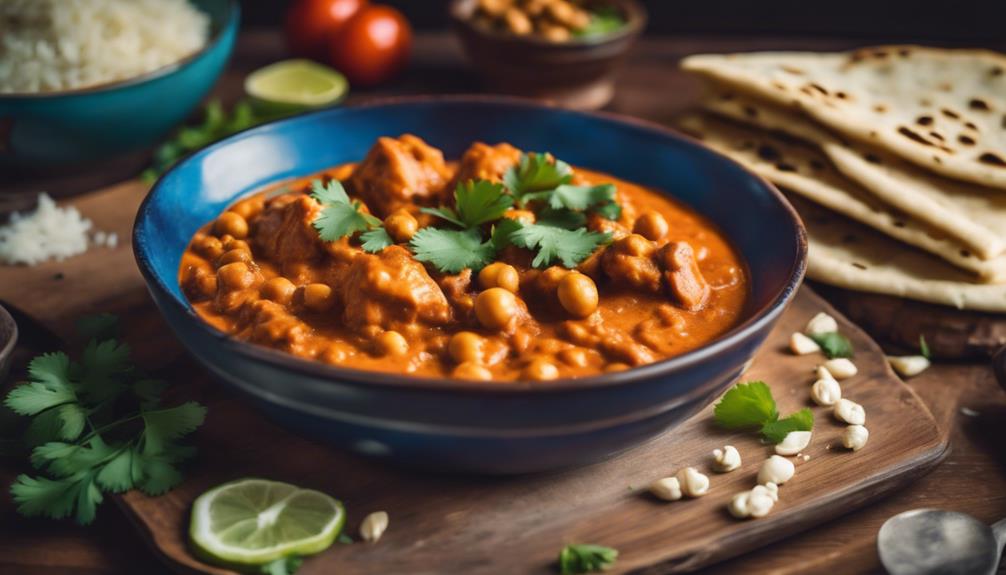
Chana Masala, a hearty and tangy chickpea dish, pairs wonderfully with the creamy richness of Butter Chicken. This vegetarian delight is made with chickpeas simmered in a vibrant blend of spices, tomatoes, and onions. The result is a dish that bursts with flavor and provides a satisfying contrast to the milder, creamy notes of Butter Chicken.
The tangy and spicy flavors of Chana Masala elevate the overall meal, making each bite an exciting experience. The chickpeas add a delightful texture and a substantial protein boost, ensuring that your meal is both nutritious and balanced. This combination of Butter Chicken and Chana Masala offers a perfect harmony of flavors and textures, appealing to both vegetarians and meat lovers alike.
Preparing Chana Masala is straightforward, yet the depth of flavor it brings to the table is remarkable. The spices used—such as cumin, coriander, turmeric, and garam masala—infuse the chickpeas with an irresistible aroma and taste. When served alongside Butter Chicken, Chana Masala not only complements the dish but also enhances it, making your dining experience more enjoyable and fulfilling.
Vegetable Biryani

Bursting with vibrant colors and rich flavors, Vegetable Biryani is an aromatic rice dish that pairs beautifully with the creamy richness of Butter Chicken. This savory and nutritious dish is loaded with mixed vegetables like carrots, peas, and bell peppers, making it a delightful addition to your meal. The tender vegetables combined with fragrant spices create an irresistible aroma that complements the mildly spiced Butter Chicken perfectly.
When you dig into Vegetable Biryani, you'll notice how the savory and slightly tangy taste balances the richness of Butter Chicken. The rice dish's layers of spices and textures not only add depth to your plate but also enhance your overall dining experience. Each bite offers a burst of flavors, from the sweetness of the vegetables to the warmth of the spices.
Vegetable Biryani isn't just about taste; it's also a nutritious choice. The mixed vegetables provide essential vitamins and minerals, making your meal both satisfying and wholesome. Whether you enjoy it on its own or paired with various curries, Vegetable Biryani stands out as a versatile and flavorful companion to Butter Chicken, elevating your culinary journey.
Mushroom Masala

After enjoying the intricate flavors of Vegetable Biryani, you might discover Mushroom Masala to be an equally delightful and hearty companion to Butter Chicken. This flavorful Indian dish showcases fresh mushrooms cooked in a rich, aromatic gravy. The earthy essence of mushrooms blends seamlessly with the creamy and spicy sauce of Butter Chicken, creating a well-rounded pairing.
Mushroom Masala is a fantastic vegetarian option that guarantees everyone at your table can partake in the feast. The dish's combination of tender mushrooms and bold spices adds a layer of depth to the overall meal experience. Plus, it's a great way to include more vegetables into your diet while relishing the traditional tastes of Indian cuisine.
Here's why Mushroom Masala is an exceptional choice:
- Earthy mushrooms: Their innate flavor complements Butter Chicken's creamy sauce.
- Vegetarian option: Ideal for guests who prefer plant-based dishes.
- Bold spices: Enhance the dish and enrich the meal's complexity.
- Hearty accompaniment: Ensures you feel content and nourished.
Roasted Aloo Gobi

Roasted Aloo Gobi brings a delightful harmony of flavors and textures to your Butter Chicken meal, with its crispy potatoes and tender cauliflower. This flavorful Indian vegetable dish is a popular side dish that perfectly complements the creamy and rich flavors of Butter Chicken.
The combination of roasted cauliflower and potatoes offers a satisfying texture and taste contrast to the spiced chicken curry, making every bite a balanced and enjoyable experience.
Roasting the vegetables enhances their natural flavors and creates a delicious caramelization that adds depth to the dish. The crispy edges of the potatoes and the slightly charred cauliflower florets bring a unique and delightful crunch that contrasts beautifully with the smooth and creamy Butter Chicken sauce.
This pairing not only satisfies your taste buds but also adds a hearty and comforting element to your meal.
As a versatile and nutritious side, roasted aloo gobi ensures your Butter Chicken dinner is both satisfying and well-rounded. The simplicity of the ingredients—cauliflower and potatoes—combined with the rich spices used in Indian cooking, makes this dish a go-to choice for anyone looking to elevate their Butter Chicken experience.
Enjoy the perfect pairing and savor the delightful combination of flavors.
Frequently Asked Questions
What Vegetable Goes Well With Butter Chicken?
You'll find that vegetables like spinach, cauliflower, and okra go really well with butter chicken. Try crispy bhindi masala or invigorating cucumber raita to balance out the rich and creamy flavors of the dish.
What Vegetables Go Well With Curry Chicken?
Oh, the age-old question of curry chicken pairings! You can't go wrong with spinach, cauliflower, or potatoes. For those feeling adventurous, try okra, bell peppers, or peas. Even eggplant or green beans can elevate your dish.
What Is the Best Vegetable to Eat With Chicken?
You can't go wrong with roasted Aloo Gobi. The combination of cauliflower and potatoes not only complements chicken but adds a delightful texture and flavor. It's a classic choice that enhances any chicken dish beautifully.
What Is the Traditional Way to Eat Butter Chicken?
You'll traditionally eat Butter Chicken with fragrant basmati rice or warm garlic naan bread. These sides provide the perfect contrast in texture and flavor, enhancing the rich, creamy sauce of the Butter Chicken.
Conclusion
Choosing the perfect vegetable to pair with butter chicken is like finding the ideal dance partner; it enhances the whole experience.
Whether you go with the creamy Palak Paneer, the spicy Aloo Gobi, or the flavorful Chana Masala, each option brings its unique flair to the table.
Don't hesitate to mix and match or try something new. Your taste buds will thank you, and your meal will be unforgettable.
So, what'll you try first?
